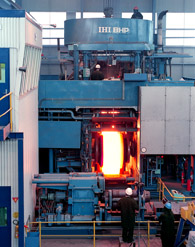
Casting thin sheet steel
2000
more efficient technology for producing thin sheets of steel
Making a thin sheet of steel to turn into a garden shed, car panel or roof gutter involves intensive effort.
The traditional process requires several steps, beginning with liquid steel at about 1500°C. The liquid steel is formed into a slab of solid steel about 20cm thick. This slab is squeezed between rollers in several stages when hot and again when cold, until it is about 1mm thick and 2m wide. For over one hundred and fifty years the dream of steelmakers has been to turn liquid steel directly into thin sheets avoiding all the steps in between.
Australian company BHP and Japanese company IHI jointly pioneered casting of thin steel between 1989 and 1999. During this time they set up laboratory and pilot plants in Australia. They developed the technology to successfully produce 1mm sheets of steel directly from liquid steel.
In 2000 the companies entered a joint venture with Nucor, a US steelmaker, for worldwide licensing of their patents and technology and the sale of equipment. They formed a company to market the technology, Castrip LLC, 47.5% owned by BHP. In South East Asia and Australasia, BHP has retained the rights to the technology. In 2001, construction began on the world?s first commercial strip casting plant for low carbon steel at Nucor?s plant in the USA, using components and technology from the original Port Kembla, NSW, strip caster plus new equipment.
The new technology is cheaper and has reduced capital costs compared to conventional technology. It can use recycled scrap steel with higher levels of impurities. As it requires less land and building space, the plant can be located near consumers or suppliers, reducing freight costs. It also has improved energy efficiency, halving energy use and reducing greenhouse gas emissions by at least 40% when compared to thin slab casting.
Who Did It?
Key Organisations
BHP Limited
IHI (Ishikawajima-Harima Heavy Industries Co., Ltd), Japan
Nucor Corporation, USA
Key People
Les Gore
Wal Blejde
Dr. H. Fukase
Dr. Les Strezov
Further Reading
?BHP in US deal to license steel-casting?
Ian Porter
Sydney Morning Herald, 29 January 2000, p 97.
Links
BHP Steel
Nucor Corporation
IHI
New Steel Online Magazine
Iron & Steelmaker Magazine
How steel cans
are made
Related Innovations
Froth floatation process
Durable heavy rail technology
|










